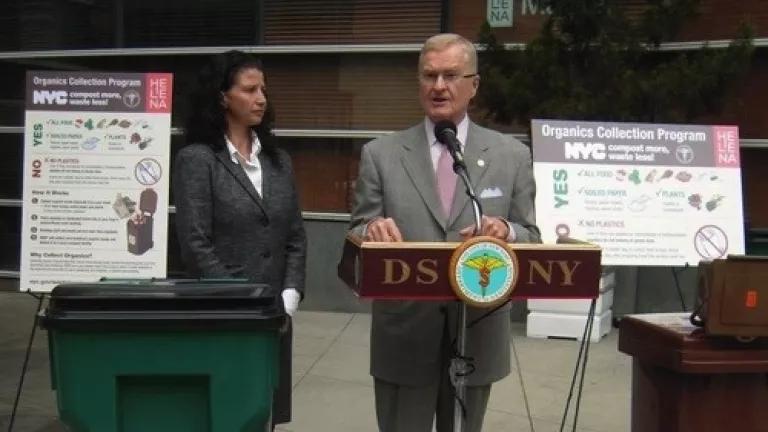A National Model for Sustainable Food Waste Disposal Is Being Created Where? Right Here in New York City

The New York Times is giving front page coverage today to the latest plans by New York City Mayor Michael Bloomberg for advancing composting and environmentally sound waste measures for disposing of food scraps collected in the nation’s largest city. And the media attention is well-deserved.
If the Bloomberg Administration’s new food waste collection programs are successful, they will constitute the biggest change to waste handling here in New York since curbside recycling collections of paper, metals, glass and plastic began more than 20 years ago.
Food waste is the largest single portion of the residential waste stream. It accounts for more than 20 per cent of municipal trash, both in New York City and around the nation. Leaf and yard wastes --which are also compostable and can be collected together with food scraps -- account for another five per cent or more.
Right now, more than 97 per cent of food wastes and a large portion of leaf and yard wastes are being transported to landfills and incinerators. This is an expensive proposition and one that creates unnecessary environmental burdens for our air, water and land.
In contrast, as Mayor Bloomberg and his Sanitation Department have concluded, the separate collection of food waste and yard waste for use as compost and/or energy generation, can save taxpayer dollars and reduce global warming emissions.
Here in New York City, the food waste collection program is beginning in three different arenas.
The first is single-family residences, where the initial curbside organics collection program was rolled out in one Staten Island neighborhood. It has already secured a household participation rate of 43%. And the food and yard waste bins are being filled almost exclusively with only food wastes and yards waste (the city reports a contamination rate of less than one per cent).
Next, the city has begun collecting food wastes from lunchrooms in nearly 100 city schools. This is terrific because as school kids learn to participate in the program they will take their knowledge home; they become the recyclers and composters of tomorrow. The city plans to have the school lunchroom composting program up and running in more than 400 city schools by December.
Third, the city has begun testing the curbside collection of food waste in residential high-rise buildings. Leading the way is The Helena -- a modern, 38 story, LEED gold building on Manhattan’s west side. With cooperation from the Durst Organization and building residents, all 600 units are able to participate in the program and turn their food waste into compost that can be used in parks, community gardens and neighborhood beautification projects.
“New York City’s Mayor Michael Bloomberg is advancing plans to transform waste handling in the nation’s largest city. In addition to curbside collection of food waste at single family homes and throughout the city’s public schools, his Sanitation Department has begun the first curbside food waste collection program at a Manhattan high-rise -- The Helena – pictured here.”
Of course, the foundation for the Mayor’s recent announcement was laid by organizations like the Lower East Side Ecology Center and Grow NYC, which have been demonstrating the opportunities of composting by collecting food waste at the city’s Greenmarkets for many years. Their successes have inspired city waste planners.
Significantly, two of the candidates vying to succeed Mayor Bloomberg in office – City Council Speaker Chris Quinn and Public Advocate Bill DeBlasio – have indicated their strong support for the Mayor’s new food waste initiative. Indeed, Speaker Quinn, according to the Times, has even suggested that she will seek to advance legislation this summer to establish food waste collection pilots in other boroughs, so that the voluntary phase of the program will be sure to continue into the next Administration.
This is similar to the way in which other curbside composting programs rolled out in places like San Francisco and Seattle. They began as voluntary operations for a number of years while the public became familiar with the concept and as municipal leaders worked out the kinks and the operational details. These programs have since become mandatory. And they are succeeding in significantly reducing wastes sent to landfills and in saving taxpayer dollars.
In addition to Seattle and San Francisco, curbside food waste collection programs are now operating in well over 100 jurisdictions around the country from Portland, to Boulder, to Princeton to Cambridge. San Antonio has just added a curbside collection program and cities like Boston are giving the idea a serious look.
If New York City, with all of its complexities can make curbside food waste collections work, it will indeed serve as a model for other municipalities to consider.
Thus, Mayor Bloomberg, his chief of staff Cas Holloway, along with Sanitation Commissioner John Doherty and his deputy Ron Gonen, all deserve a round of applause. And the New York Times, by placing this story on the front page, has caught onto something for forward-looking municipal waste planners in other cities to chew over.

